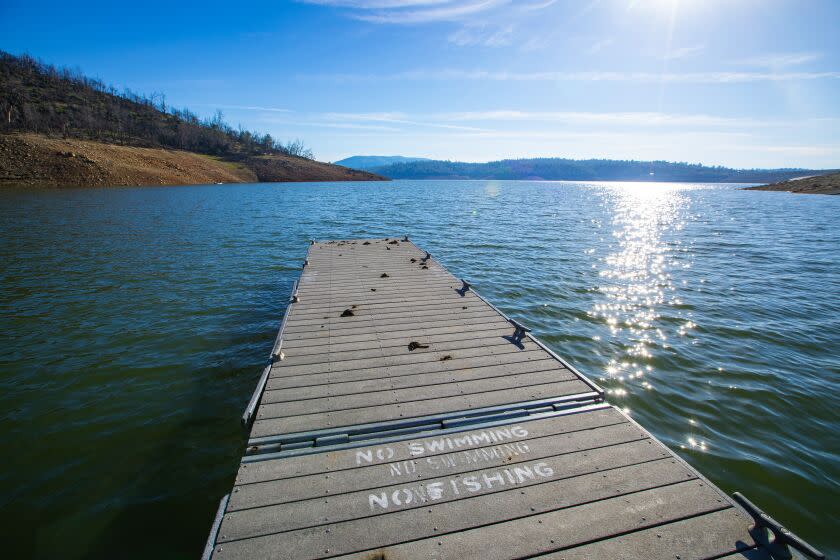Lake Oroville is 100% full as California reservoirs are revived by historic rain and snowmelt

California's second-largest reservoir is now completely full after a historic rainy season recharged reservoirs across the state following years of drought.
Lake Oroville, fed by the Feather River about 80 miles north of Sacramento, is at 100% of its capacity, according to the California Department of Water Resources.
Since Dec. 1, the lake's water level has increased more than 240 feet thanks to more than 2.5 million additional acre-feet of water brought on by a series of powerful winter storms and the melting of a historically deep snowpack. That puts the reservoir at 127% of its historical average for the date, state data show.
Scattered showers arrived Tuesday afternoon in the Sierra Nevada and areas east of Oroville, according to the National Weather Service, but dam operators at the reservoir do not expect a deluge of water or a risk of flooding downstream.
The Department of Water Resources has increased the outflow of water from the main spillway at Oroville Dam and an outlet farther south to ensure the full reservoir can hold snowmelt without overflowing. Officials noted that scattered waves could crest over the dam's emergency spillway, which was repaired after nearly collapsing in a 2017 storm.
Tracy Pettit-Polhemus, supervising engineer for the DWR’s State Water Project Operations Control Office, said in an email that the agency increased the outflow from Oroville in recent months but started to ramp down on Tuesday. There is no potential for flood risk, according to Pettit-Polhemus.
Peak inflow at Lake Oroville occurred in April and is trending downward, though it could tick up at times due to a late-season storm or increased snowmelt from a heat wave, State Water Project official John Yarbrough told news station KCRA.
It's a far cry from the situation in 2021, when Lake Oroville was at 24% capacity and the state was pockmarked with dry lake beds after three consecutive drought years.
Farther north, Shasta Lake — which now sits at 97% full — was at 38% of capacity in the middle of last summer, boasting an unmistakable "bathtub ring" high above the water, showing where levels at California's largest reservoir typically reach in a healthy rain season.
In October, the U.S. Bureau of Reclamation’s Central Valley Project, which manages Shasta Lake and its outflow, reported that the water year would start with just 3.6 million acre-feet of storage water, marking one of the lowest figures in recent years. The federal agency said it would be "increasingly difficult, if not impossible" to meet all the demands of its customers across 29 counties.
California also asked its customers to prepare for extremely limited water supply conditions due to projected shortages. Department of Water Resources Director Karla Nemeth said California was in "the dawn of a new era" because of climate change and people would need to adapt.
But a very dry California ended 2022 with a strong, wet rainy season that carried over into 2023 for several weeks. Reservoirs and lakes across the state bounced back.
The drastic cuts projected by the DWR all but evaporated in April when the state agency said it would be able to deliver 100% of requested supplies from its 29 public water agencies for the first time since 2006. The U.S. Bureau of Reclamation also said it would deliver 100% of requested water allocations for most regions served by the federal Central Valley Project.
A year ago, all of California was experiencing some level of drought, according to the U.S. Drought Monitor, and about 12% of the state was gripped by exceptional drought conditions, the highest tier. The latest data show that none of the state ranks any higher than moderate drought, with more than 70% of California not experiencing any abnormally dry conditions.
What exactly that means for California's future is unclear.
California rolled back some of its severe drought restrictions after the rainy season, but Gov. Gavin Newsom did not declare the drought over.
“It’s incumbent upon us to continue to maintain our vigilance and maintain some provisions of the executive order to allow for fast-tracking of groundwater replenishment projects, stormwater capture and recycling programs here in the state of California,” he said in March.
Pettit-Polhemus with DWR said while the most recent deluge of rain helped build up the state's snowpacks, it's not going to turn around California's drought situation.
"While this precipitation has helped surface water supplies and eased impacts from the state’s record-breaking drought, California’s groundwater basins are still depleted due to prolonged dry conditions and will require more than a single wet year to recover," she added.
This story originally appeared in Los Angeles Times.

